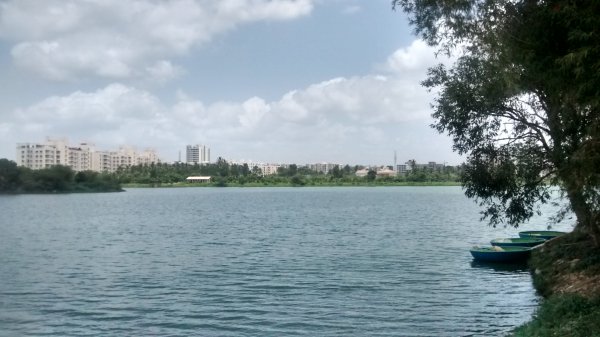Field trip to Jakkur Lake
Conducted by S Vishwanath and Biome Environmental Solutions
3 January 2016 (afternoon)
In India today, urban areas are suffering from water shortage and waste-water pollution, owing to their fast pace of economic growth and increasing water demand and the inability of institutions to cope with this rapid growth.
Bengaluru is a particularly important example of such a situation. Located in the South of India at an average elevation of 900m above sea level, it is India’s fifth largest metropolitan city, currently home to over 9.5 million inhabitants. Bengaluru has one of the costliest water in India simply because all water it consumes comes from a distance of 95 kilometres and has to be pumped up 300 metres. With a daily supply of 1400 MLD through this source, the city is unable to meet the current demand of 1800 MLD. Once known as the city of lakes, in 1960, there were approximately 282 lakes while today, barely 81 remain. The city has lost more than one lake a year to the growing demands of the human population and change in land use.
This makes it extremely important for the city to look at alternative sources of water for its survival, namely, rainwater, groundwater and treated waste-water. Under the paradigm of integrated urban water management, the idea is to create water sustainability zones within the city using these water sources.
Directions from hostels to Department of Management Studies, IISc
The Jakkur Lake Revival Project
Located in Northern Bengaluru, the 1.5 km long Jakkur Lake is rich in biodiversity, supports the livelihood of fishermen, has several wells around it that cater to the domestic needs of local residents, and is also culturally and spiritually significant for the people in this area. Unfortunately, the Jakkur lake was polluted with sewage and garbage and was being encroached upon.
Jakkur lake was revived using the STIFLE model which integrates the Social, Technological, Institutional, Financial, Legal & Ecological aspects that govern the water sustainability within a particular area. Community ownership and support from all stakeholders was key to achieving social sustainability.
A 10 MLD Sewage Treatment Plant (STP) was set up and a man-made wetland created at the northern tip of the lake, to recharge the lake with treated water from the 12,500 households surrounding it. The wetland acts as a natural filter, improving the quality of water let into the lake. It also allows bio-diversity to thrive in the lake and its surrounds. The lake was fenced and de-silted. Islands were created for birds and trees were planted on the sides of the lake.
Today 100,000 liters of water is drawn daily for agricultural purposes from the biggest step well near the lake. The farmers state that the well gets recharged and returns back to its original state within a day, due to the lake. People from nearby settlements use the lake to bathe and wash their clothes and utensils. Fishermen are able to collect at least 100 kilograms of various kinds of fish on a normal day and and up to 500 kilograms in peak season.

